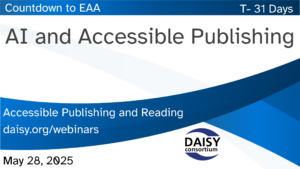AI and Accessible Publishing T-31 (W)

In our series of free webinars May 28th saw a session focused on AI and Accessible Publishing where our expert panel discussed ways of using AI in accessible publishing in a variety of ways and whether the promise of AI might become a reality.
This page contains:
Full Video of the Webinar
Speakers
- Richard Orme, The DAISY Consortium—host and chair
- Barry Bealer, Impelsys
- Øystein Moleng, Highcharts
- Saqib Shaikh, Microsoft
- Stacy Scott, Taylor & Francis
- Simon Mellins, Publishing Consultant
Session Overview
Richard Orme welcomed everyone and introduced today’s topic of AI and Accessible Publishing. Debate about Artificial Intelligence is everywhere, with new and improved services being launched every week and the promise of automating tasks and producing higher quality content. But what might these developments mean for accessible publishing? Do they offer practical solutions, or do the risks outweigh the benefits?
Barry Bealer
Barry spoke to us about the Impelsys platform, MONK (Monetizing Knowledge) which serves publishers globally and is formed of 3 parts – a publishing module, a delivery module and an AI hub. The AI hub is generally used to perform discreet tasks efficiently. One example of this is the alt text generator within the hub which can work with individual images or images in bulk and it remains vital that there is still some human interaction by asking us to provide prompts. These prompts ensure that the alt text generated takes into account style, best practice and editorial nuances that are required by the client. There is also the option to upload chunks of content so that the AI can create alt text that aligns with the context.
Barry was very clear that AI is not perfect – that it requires human intervention and this was exemplified by some of the medical and engineering samples shown.
Additionally Impelsys have created best practice around the use of AI including governance, policies and procedures, which provide a set of guard rails for the use of AI.
Øystein Moleng
Øystein spoke to us about creating data visualizations that are accessible in terms of creation / authoring and analysis.
When creating data visualizations that are accessible there are a number of ways that AI can be of assistance. Highchart’s online coding assistant helps the author create line charts by generating the required code and during the demo we saw how accessible this can be, straight out of the box. Other areas where AI is a help include the use of AI to automatically digitize materials to become useable accessible resources.
From the consumer’s perspective this should make a huge difference:
You want to learn something, you want to come away with something that lets you make a decision based on the data.
The AI has to be reliable enough to allow the user to do this and that can be a challenge. The mis-interpretation of data in large language models (LLMs) can lead to quite harmful mistakes especially when the AI driven results are so convincing. This will be resolved at some point in the future but for the moment it is best to allow the AI to create the structured data but to stick with tried and tested methods for its analysis.
Saqib Shaikh
Saqib spoke about the Microsoft mobile app Seeing AI, which acts like a visual assistant to empower people who are blind or have low vision. The app has been in existence for a number of years but the technology driving it has progressed hugely in the last few years especially when it comes to reading which affects all areas of our daily lives. As a blind student himself, Saqib experienced all flavours of accessible publishing and his own first hand experience of learning and he is particularly excited about the generative AI movement. By understanding and interpreting documents at a much greater level than ever before Saqib thinks that this opens up opportunities for users to focus on the material itself. There remain challenges for advanced material that involves more than straight forward text. We should remember that human involvement is needed.
It’s a partnership between humans and machines
With these challenges in mind, Saqib encouraged publishers to start experimenting with AI. He is excited to see what the future holds and he anticipates it involving extreme personalisation as we all consume content differently and AI will allow us to do that.
Our readers will be interested in listening to the Q & A section of the webinar when invited experts Stacy Scott (Taylor and Francis) and Simon Mellins joined Saqib to answer questions submitted and engage in lively discussion around all aspects of using AI in publishing and reading.
Related Resources
Our presenters and their organizations:



